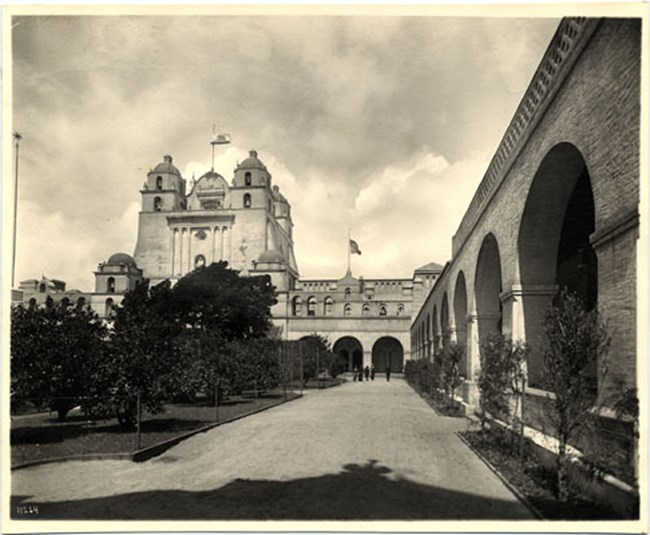
SFPL Northwest of the palaces, set along the marina shoreline were the State buildings. They rested along either side of the aptly named Avenue of the States which ran west-east from the Polo Field and Stock Exhibits to the California Building. A careful inspection of the exposition map will reveal a few buildings among the state group conspicuously lacking a title. In 1915 forty eight stars donned the flag of the United States of America-Alaska and Hawaii having yet to join. Of the forty eight invitees, twenty six were able to participate. Monetary concerns were a prevailing reason, but not the only, for many of the state’s inability to contribute. The aforementioned unnamed plots were intended for the unfortunate states that were present for plot selection festivities, yet fell short in their efforts to contribute. The Hawaiian Islands and the Philippines each received a building as territories. New York City received its own building, while Arkansas and Oklahoma shared a building making it twenty eight buildings total. The opening day roster also included: California(naturally), Ohio, Illinois, Oregon, Texas, Washington, West Virginia, Wisconsin, Indiana, Iowa, Kansas, Missouri, Massachusetts, North Dakota, Pennsylvania, New York, Idaho, Maryland, Virginia, Montana, Utah, Mississippi, Nevada, and New Jersey. State buildings were multipurpose. They functioned as headquarters for their respective commissions and served as showcases for the various industries and innovations. The exhibits consisted of, but were not limited to: picture shows, art galleries, agricultural displays, city planning, and education practices. Some of the buildings had no exhibits at all, but acted as a home away from home for the many California transplants and exposition visitors. They could be seen frequenting their respective states to check the local news, collect mail in the post office, or relax and be reminded of home. Each building was dedicated with much pomp and circumstance. Speeches were given and parades were held. Every dedication was marked with the planting of a tree native to that area. Some of the buildings and their dedications are featured below-but there is much more than can be covered here with due justice. California Building Dedicated May 11 San Francisco, California was hostess to the world. It was by no mistake that the California building was the largest state building and occupied the largest plot of land at five acres. In fact, it was the largest state building constructed for any US World Fair. All fifty eight California counties were represented within. The building was designed in the spirit of the old missions that litter the state’s landscapes. To the east was the exposition boat harbor and to the west the Avenue of the States and the Esplanade which ran across the entrance. The bay lay at the northern edge of the building allowing for a gorgeous view across the water to the land beyond. The building was home to the administrative offices, the county exhibits, the great ballroom and the dining room. It was here that the many dinners and dances were held for the various commissions and dignitaries both foreign and domestic. There was dancing and music daily for visitors. Oregon Building Dedicated March 1 The Oregon state building rested some 214 feet below the stars and stripes and our flag billowed from the Astoria Flag Pole. The pole was cut from a single Douglas Fir and was topped by a large gilded star which measured 10 feet across. The colonnade lining the front of the main structure was built of forty eight singular tree trunks, each being forty two feet tall. At the dedication, Exposition Vice President R. B. Hale presented the memorial plaque to the representative of the Governor of Oregon-Commissioner R. A. Booth. Hale spoke, “Your people and our people have been interested in the development of this great country since the achievement of Lewis and Clark. We have stood shoulder to shoulder on many an occasion and shall always do so.” 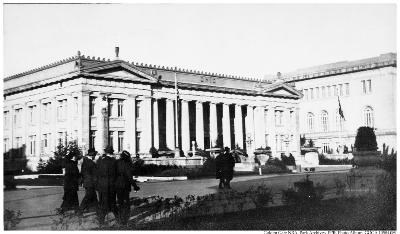
Ohio Building Dedicated February 25 The Ohio Building dedication was heavily attended. Of the thousands in attendance, notables included: current Senator and future President Warren G. Harding and Rufus Putnam, whom raised the ceremonial Stars and Stripes. Rufus’ great grandfather General Rufus Putnam had purchased the land that would become Ohio just 127 years earlier. Philippine Pavilion Dedicated February 26 The Philippine pavilion fittingly sat at the edge of both the foreign pavilions and the state buildings. The war with Spain brought attention to the need for the Panama Canal and the Philippine Islands under U.S. control. Fifteen years later, the progress of the Philippines as a US territory would be showcased at the exposition bearing the canal’s name. At the dedication of the Philippine Pavilion, a speech was delivered in Spanish, by the President of the Philippine Board and a founder of the Philippine Partido Democrata, Dr. Leon Maria Guerrero. Guerrero took the opportunity to speak of the Philippine’s desire for independence saying, “People of America, the Filipino’s bless you because they hope from you with the faith of a believer their complete political emancipation.” 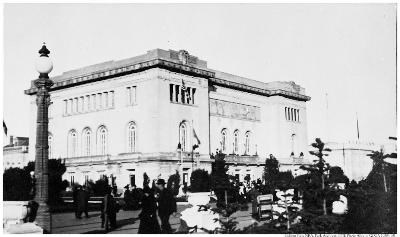
Illinois Building Dedicated February 26 “The Illinois Building came near being a temple to Abraham Lincoln,” and was dedicated with an organ concert, vocal solos, numerous speeches and the presentation of the commemorative plaque. Exposition President Moore lauded Illinois for providing the most Californians of any Eastern State-a full 110,000 of who live within a 50 mile radius of San Francisco. Hawaii Building Dedicated March 1 They were clear skies overhead as 35 singers bedecked with leis lead the precession from Scott Street to the Hawaiian Territory Building for its dedication. Their songs “…in Mark Twain’s immortal prose, brought back to many a hustled mainland dweller ‘the breath of flowers that perished twenty years ago.’” The building bore the names of the six islands. Hawaiian Princess Kalanianiole was present, as well as Mrs. Victor S. Houston, a member of one of Hawaii’s oldest families, whom acted as hostess. Within the building were many agricultural displays and botanical features. The most popular feature by far was the aquarium. Upwards of 20,000 people attended in a single day and lines had to be managed. The maintenance of such an aquarium proved difficult. The water in the aquariums was replenished weekly from the waters near the Farallones. Despite the best efforts and intentions of those involved, many of the fish died over the run of the fair and had to be constantly replaced by new members from their indigenous homes 2000 miles away. Oregon Building Dedicated March 1 The Oregon state building rested some 214 feet below the stars and stripes as our flag billowed from the Astoria Flag Pole. The pole was cut from a single Douglas Fir and was topped by a large gilded star which measured 10 feet across. Exposition Vice President R. B. Hale presented the memorial plaque to the representative of the Governor of Oregon-Commissioner R. A. Booth. Hale spoke, “Your people and our people have been interested in the development of this great country since the achievement of Lewis and Clark. We have stood shoulder to shoulder on many an occasion and shall always do so.” Texas Building Dedicated March 2 The sky shone down brightly upon the dedication of the Texas Building. This made the occasion all the more gratifying as the participation of Texas was in doubt for a time. Texas law prohibited the use of public funds for exhibits outside of the territory. It was for this reason that a small but determined group of women raised the funds themselves by subscription-rather than see Texas omitted. The dedication commenced, in the presence of cowgirls and boys, with the rebel yell. 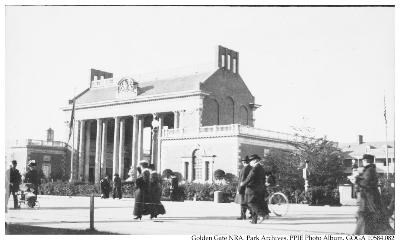
Pennsylvania Building Dedicated March 18 Clear skies greeted visitors to the Pennsylvania Building dedication. The building itself seemed designed as a shrine to the famous Liberty Bell, which was peculiar but wishful, as Philadelphia had not yet decided to allow the Bell to travel across the country to the expo. Expo President Moore used the dedication speech as an opportunity to rally for the cause, expressing his regret that the bell had not been sent there “where it belongs”. The orator, former Governor of Pennsylvania John K. Tener, made mention of the many firsts to which the Keystone State laid claim, including the first International Exposition held in America. The exposition president and many attendees had their wish granted. After much pressure was applied, the Liberty Bell arrived at the Panama Pacific International Exposition on July 17th. The bell entered the expo in a parade that traveled up Grove to Van Ness and entered the fair on the Scott street entrance. After a lavish ceremony, the bell was moved to the Pennsylvania Building where visitors could view the historic item. On November 10, 1915, the bell was given a farewell tribute and the next day it began its trip home to Philadelphia. The Liberty Bell would eventually travel 16,000 miles through 24 states in its journey. 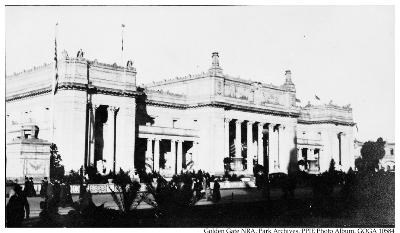
New York State and City Buildings Dedicated March 19 and April 6 New York did not host a single exhibit in the three story tall pavilion they had built for themselves. Instead, the Empire State used their considerable wealth and power to gain traction amongst the many palaces and secured the copious space for its various exhibitors within. The building itself served as a headquarters from which to conduct business, a venue for dinners and events and a place for native New Yorkers to frequent during their visit. New York was the only city to sponsor a building. It was here that many of the exhibits which filled various state buildings resided for New York. This in part allowed them to dedicate the massive state building to other means. A single person could have spent
24 hours a day every day the expo was open and still not seen it all... Visit the Exposition Palaces where the
world showcased their very best Head west of the main exposition
grounds to visit the State Buildings Take a tour of the world as you walk
along the Avenue of Nations and view the Foreign Pavilions The Presidio has a long military
history. See how the Military's Role shaped the
expo. Visit the most sensational sixty five acres at the exposition along The "Joy" Zone Aviators, athletes and drivers competed during the year of the exposition in many types of Sports and Athletics For More Information:
|
Last updated: February 28, 2015
